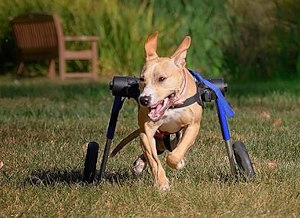
The submit Why Is My Canine Shaking? by Arden Moore appeared first on Dogster. Copying over complete articles infringes on copyright legal guidelines. You is probably not conscious of it, however all of those articles had been assigned, contracted and paid for, so they don’t seem to be thought of public area. Nevertheless, we recognize that you simply just like the article and would find it irresistible should you continued sharing simply the primary paragraph of an article, then linking out to the remainder of the piece on Dogster.com.
Shake. Shiver. Tremble. Quiver. All describe the deliberate — and typically uncontrollable — physique motion by canine.
Canine shake their our bodies for a wide range of causes that run the gamut from displaying utter pleasure to warding off chilly temperatures to coping with a severe underlying medical situation.
Some causes of this physique shaking are straightforward to determine, akin to witnessing a noise-phobic canine tremble out of worry on the explosive sounds of thunder or fireworks. In different cases, the explanation behind the physique shaking could also be onerous to pinpoint. Working example: canine with congenital types of epilepsy don’t normally develop shaking seizures till they’re round age 2.
Backside line: Sure, many behavioral, medical and environmental causes are behind physique shaking in canine. By no means ignore or dismiss doggy shakes. All the time seek the advice of your veterinarian to determine the trigger, recommends Dr. Nicholas Dodman, a board-certified veterinary behaviorist, chief scientific officer on the Heart for Canine Habits Research and best-selling pet writer.
Dr. Lisa Radosta, a board-certified veterinary behaviorist who runs the Florida Veterinary Habits Service clinic in West Palm Seashore, Florida, agrees.
She advises pet dad and mom to instantly report all particular clues they see, hear or odor of their shaking canine. In addition they ought to describe the environments to their veterinarians to be able to determine the explanation and give you attainable cures. Particularly take motion in case your canine is shaking for greater than 20 minutes, refuses to just accept a deal with or can’t be distracted, provides Dr. Radosta.
Let’s first determine some medical causes after which spotlight some behavioral and situational triggers.
Medical causes of canine shaking
A number of medical situations can spark uncontrollable shaking in canine. These embrace:
- Addison’s illness: Medically known as hypoadrenocorticism, this situation impairs the hormone manufacturing of cortisol and aldosterone hormones by the adrenal glands positioned close to the kidneys. Intermittent physique shaking in addition to power diarrhea, elevated thirst and weight reduction are among the many telltale signs. Many canine identified and handled with an injection treatment and/or oral treatment expertise a superb prognosis.
- Hypoglycemia: Canine with this low blood sugar situation will usually expertise tremors, lose their appetites, really feel weak and should even faint. Poor diet, most cancers and liver failure are among the many many attainable causes. Remedy varies, relying on the recognized trigger.
- Epilepsy: Whereas the reason for this mind dysfunction is unknown, there’s a genetic predisposition in sure breeds, together with Beagles, Cocker Spaniels, Golden Retrievers, Poodles and Siberian Huskies. Throughout a seizure, a canine’s physique stiffens and trembles closely. The twitching convulsions may also happen in some canine who ingest poisons. Veterinarians usually prescribe anticonvulsant drugs to scale back the quantity and severity of seizures.
- Shaker Syndrome: This neurologic situation is also referred to as generalized tremor syndrome and causes head and physique tremors in some canine. It’s not recognized why, however most at-risk breeds are white and embrace Maltese, Poodles and West Highland White Terriers (Westies), however any breed could be affected. Veterinarians might prescribe corticosteroids to scale back episodes.
- Publicity to toxins: Uncontrollable physique shaking can happen in canine bitten by venomous snakes in addition to by ingesting marijuana. Xylitol, a man-made sweetener, is in a rising variety of meals, together with peanut butter. The opposed response to xylitol is 100 occasions extra extreme than that of darkish chocolate containing theobromine if ingested by canine — and ingesting theobromine is dangerous. Remedy and restoration rely upon the trigger and promptness of veterinary care.
Preventive actions embrace retaining canine on leashes in wooded areas the place snakes are, retaining harmful meals or vegetation out of a canine’s attain and punctiliously studying the labels of peanut butter and different meals/candies to make sure they don’t comprise xylitol.
Canine shaking as an indication of happiness, nervousness or worry
Our canine expertise a variety of feelings, identical to us. Some canine gleefully do full-body wiggles when being reunited with a favourite one who has been away for a very long time. That is undoubtedly pure-joy wiggle motion that signifies a robust friendship bond between the canine and the individual.
Dr. Radosta calls this pleased motion in canine because the noodle wiggle. Though the physique is transferring aspect to aspect, the muscle groups are relaxed.
Nevertheless, many canine shake or tremble because of feeling afraid, anxious or burdened. The sight and sound of thunderstorms, a loud vacuum cleaner, the screech of a skateboard’s wheels or different noises trigger a fight-or-flight mindset in some canine.
Whether or not the risk is actual or perceived, an affected canine reacts bodily by pacing, whining, trembling, panting and even shedding excessively. A canine’s amygdala, the portion of the mind that controls feelings, releases fight-or-flight hormones, adrenaline and cortisol, explains Dr. Radosta.
Dr. Dodman, who has co-authored many behavioral canine research on the influence of such feelings, shares his house together with his now-senior canine, Rusty. He adopted Rusty as an 8-month-old from an animal shelter and shortly found that Rusty got here with separation nervousness and a shaking, take-flight response to sure sounds and actions.
Rusty shook and ran right into a nook as a younger rescue every time Dr. Dodman shook out a big plastic trash bag earlier than placing it within the trash can within the kitchen, or every time he eliminated his belt. Rusty additionally shook and fled the kitchen if sizzling, smoky oil from a frying pan set off the smoke detector.
Dr. Dodman patiently labored with Rusty to tone down these fears. He cautions pet dad and mom to not dismiss or underestimate fears exhibited by their canine. Untreated, fears can progress into phobias, outlined as persistent, irregular fears of an individual or an object.
Remedy depends upon the canine and the extent of worry or stress displayed, notes Dr. Radosta, who treats many such canine at her clinic. She encourages pet dad and mom to imagine that their canine converse one other language. This will likely encourage you to decelerate and begin to actually observe your canine’s actions and sounds.
To assist canine who shake with worry, work with a professional canine skilled, together with veterinarians, behaviorists and licensed canine trainers. And, search regular progress, Dr. Radosta provides.
Some canine profit when given over-the-counter pure calmers akin to Zylkene, a hydrolyzed milk protein. Others might require stronger calming prescriptions. Essentially the most go-to ones prescribed by veterinarians are fluoxetine, gabapentin and trazodone.
Taking your canine on every day walks and dealing his mind with meals puzzle challenges may also assist elevate your canine’s sense of security and quietness. These workout routines launch feel-good hormones known as endorphins. So can enjoying a sound machine or classical music to muffle stress-triggering responses to listening to thunderstorms or fireworks.
Different causes for canine shaking
Many canine do full-body shakes at bathtub time to rid their our bodies of extra water. It’s automated and helps a canine dry his coat to realize a wholesome physique temperature. Dr. Dodman says that the frequency of their shaking depends upon their dimension, however all furry mammals naturally shake to rid their coats of water drops.
Publicity to chilly temperatures, particularly for lengthy durations, triggers uncontrolled shivering in canine as their muscle groups flex and calm down in an try and elevate their core physique temperature. Hairless and thin-coated canine are extra in danger than canine with thick coats and double coats.
Limiting a canine’s time in chilly climate, becoming him with a correctly sized sweater and wrapping him in a blanket indoors can counter the risks of the chilly temperatures. Nevertheless, keep away from vigorously rubbing his coat in an try and heat his physique, as chances are you’ll unintentionally worsen the unfold of frostbite injury to the pores and skin.
When two canine play, one might cease and shake his physique as a sign that he’s accomplished enjoying, provides Dr. Dodman.
And, some canine twitch when they’re sleeping. Like us, canine go into three sleep phases: non-rapid eye motion (NREM), speedy eye-movement (REM) and short-wave sleep (SWS). Veterinarians and animal scientists theorize that canine dream in the course of the REM stage and act on their goals by twitching or transferring all 4 paws as in the event that they had been chasing a squirrel.
Keep away from placing your hand on a sleeping canine as you danger harm from a startled canine who might reactively chunk. As an alternative, name your canine’s identify and converse to him calmly, permitting him to open his eyes on his personal.
As you may see, canine shake for a wide range of causes. Take note of their particular actions and locations when shaking happens, and report these findings to your veterinarian to give you the perfect sport plan to carry out the wholesome greatest in your canine.
The submit Why Is My Canine Shaking? by Arden Moore appeared first on Dogster. Copying over complete articles infringes on copyright legal guidelines. You is probably not conscious of it, however all of those articles had been assigned, contracted and paid for, so they don’t seem to be thought of public area. Nevertheless, we recognize that you simply just like the article and would find it irresistible should you continued sharing simply the primary paragraph of an article, then linking out to the remainder of the piece on Dogster.com.



